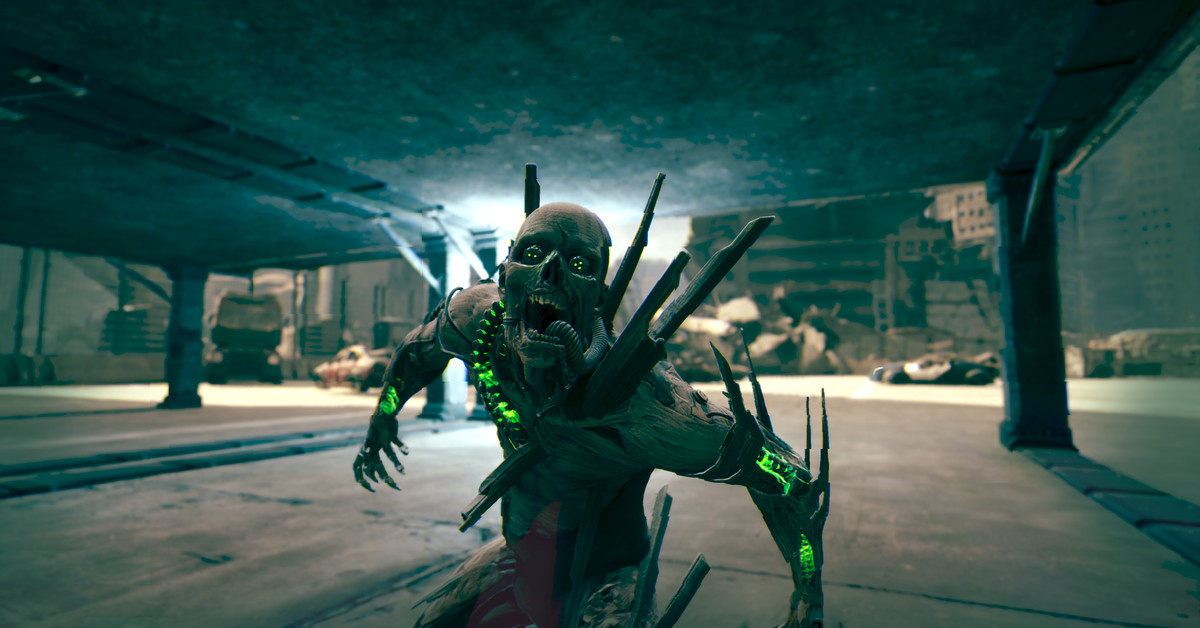The first Ghostrunner was a perfect example of no-frills excellence: a lean cyberpunk parkour-based platformer in which you and your enemies both died in one hit. The controls were tight, the story was basically nonexistent, and the environmental design was sparse and utilitarian. Every part of the game felt like it was built around Ghostrunner’s stellar kineticism. Levels were finely tuned so that each encounter pushed the game’s difficulty exactly one step further than the last, always providing a new challenge without ever feeling out of reach. With Ghostrunner 2, developer One More Level tries to build on the bare-bones approach of the original, but every addition feels like it gets in the way of the simple wall-running, jumping, dashing, and killing that made the original great.
Ghostrunner 2 takes place shortly after the events of the first game and puts players back in Dharma Tower, a futuristic spire that stands as the lone beacon of civilization in an otherwise apocalyptic wasteland. Players control Jack, one of the few remaining Ghostrunners (basically the tower’s now-defunct team of supercops), as he works with a small band of people hoping to keep the tower out of the hands of religious fanatics.
The story is meted out through near-constant in-game dialogue that mostly amounts to exposition punctuated by bland, unfunny jokes as Jack runs around different parts of the tower killing enemies. When he isn’t in the middle of a mission, Jack heads back to a home base that feels pulled directly from a big-budget RPG — each of the game’s NPCs has a small workspace area where players can chat with them via dialogue trees, asking questions about the world and their thinly sketched backstories (which usually amount to stereotypical hacker or ex-soldier origin tropes).
:no_upscale()/cdn.vox-cdn.com/uploads/chorus_asset/file/25032347/1_enemyattack.png)
Image: One More Level/505 Games
Thankfully, when Ghostrunner 2 emerges from its slog of forced story interaction, the levels themselves are still well designed, though these, too, rarely live up to the quality of the original’s. The series’ mechanics shine brightest in massive areas with dozens of enemies to dispatch via quick movements and perfectly planned timing. It’s a trial-and-error series about finding the right path to fit your preferred play style before executing it flawlessly — much like last year’s fantastic platformer Neon White. But rather than keeping the emphasis on finely crafted combat arenas, Ghostrunner 2 is otherwise packed full of environments that feel more reminiscent of a traditional adventure game: transitional hallways and small rooms with only four or five enemies to juggle.
These smaller rooms are still fun — after all, Ghostrunner’s kinetic action is always enjoyable — but they don’t invite the kind of inventive solutions that the original game did. Fighting so few enemies often becomes either trivial or frustrating, with limited approaches to eliminating opponents, rather than the freedom offered by the original’s larger, free-form environments.
:no_upscale()/cdn.vox-cdn.com/uploads/chorus_asset/file/25032366/4_enemylaser.png)
Image: One More Level/505 Games
Ghostrunner 2’s best moments arrive in the few levels where Jack acquires a new ability. These levels are all exquisitely designed around unique mechanics, forcing you to think about your new ability in increasingly creative ways while also putting your platforming to the test.
One of these powers lets Jack make clones, which he has to use to block lasers that open and close doors or spawn and despawn platforms. To get through this power’s “tutorial” level, you have to summon and dismiss the clone in rapid succession, all timed to an intricate series of tricky jumps. Another level tests Jack’s Force-push-style ability to move a series of platforms as momentum flings you toward them at speeds that mean even a slight error in timing will get you killed. There’s even a high-speed motorcycle sequence that makes for the game’s most unique and unexpected challenges.
:no_upscale()/cdn.vox-cdn.com/uploads/chorus_asset/file/25032353/02_04__2_.png)
Image: One More Level/505 Games
All of these are incredible, discrete pieces of game design that give brief glimpses at what the rest of the game could have been — but through the eight or so hours of the game I’ve played, One More Level never manages to make those powers feel necessary outside of the levels they’re acquired in. Even worse, it never feels necessary to combine many of these powers at once. Instead, rather than building toward challenges that require you to juggle all of your newfound tools, each subsequent mission feels more like a reset — a start from square one every time.
None of this makes Ghostrunner 2 a bad game, per se; its mechanics and baseline design still thrilled me on several occasions. But it lacks the cohesion and clear momentum of the first game, and its many additions never build toward a more interesting or complex game.
Making a sequel to a video game is never easy, but making a sequel to a platformer is even more difficult. Expand on too little and it feels like a level pack; iterate too much and you lose what made the original great. Sadly, Ghostrunner 2 is firmly in the latter camp. In its quest to raise its stakes, Ghostrunner 2 loses its identity. And while the game does find its rhythm every now and then, those moments are too few and far between. There’s still nothing quite like the feeling of nailing a perfect run through one of Ghostrunner’s areas, hitting the exact right line of jumps and grapples, cutting enemies at the perfect time, and adapting on the fly when needed. It’s just a shame the sequel hinders so much momentum with AAA tropes.
Ghostrunner 2 was released Oct. 26 on PlayStation 5, Windows PC, and Xbox Series X. The game was reviewed on PC using a pre-release download code provided by 505 Games. Vox Media has affiliate partnerships. These do not influence editorial content, though Vox Media may earn commissions for products purchased via affiliate links. You can find additional information about Polygon’s ethics policy here.

